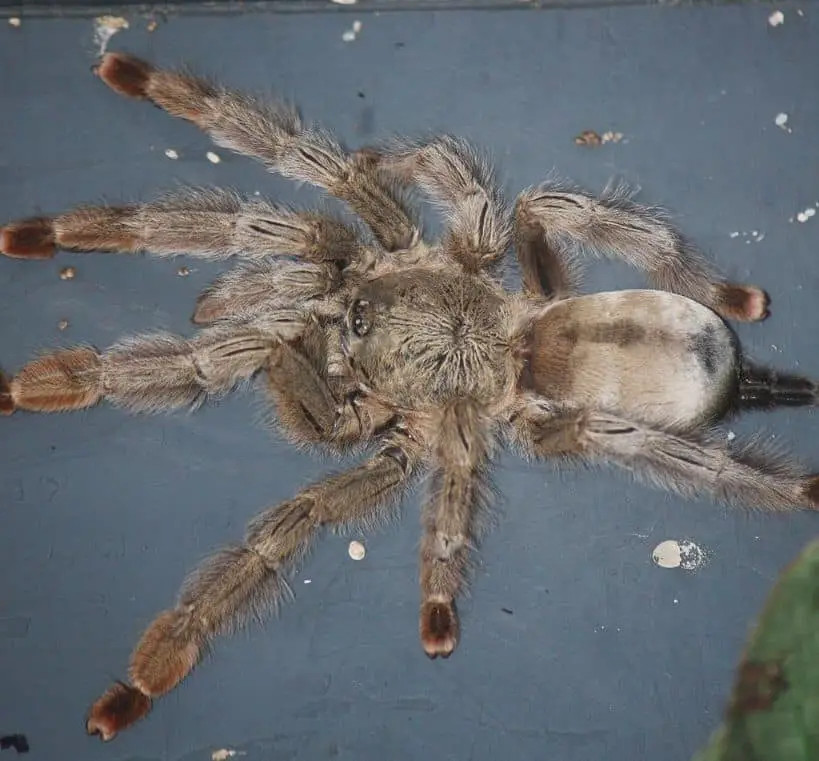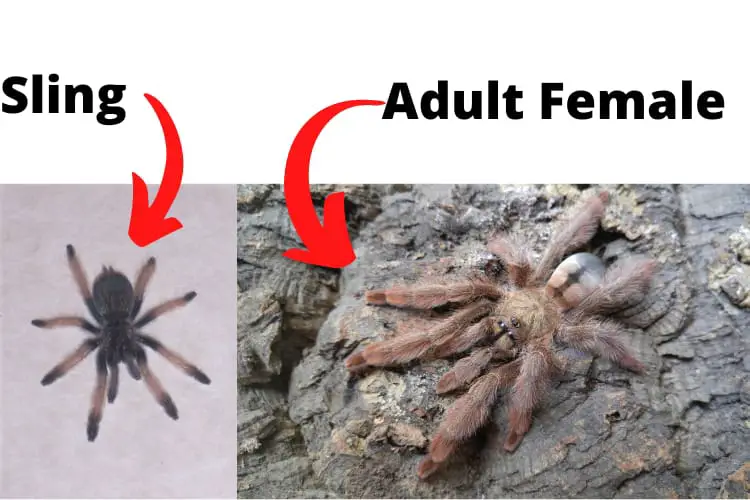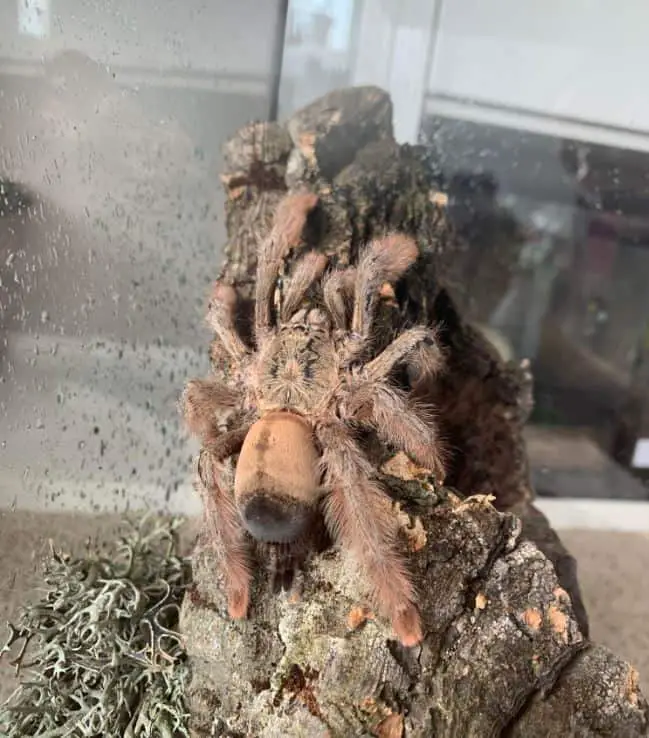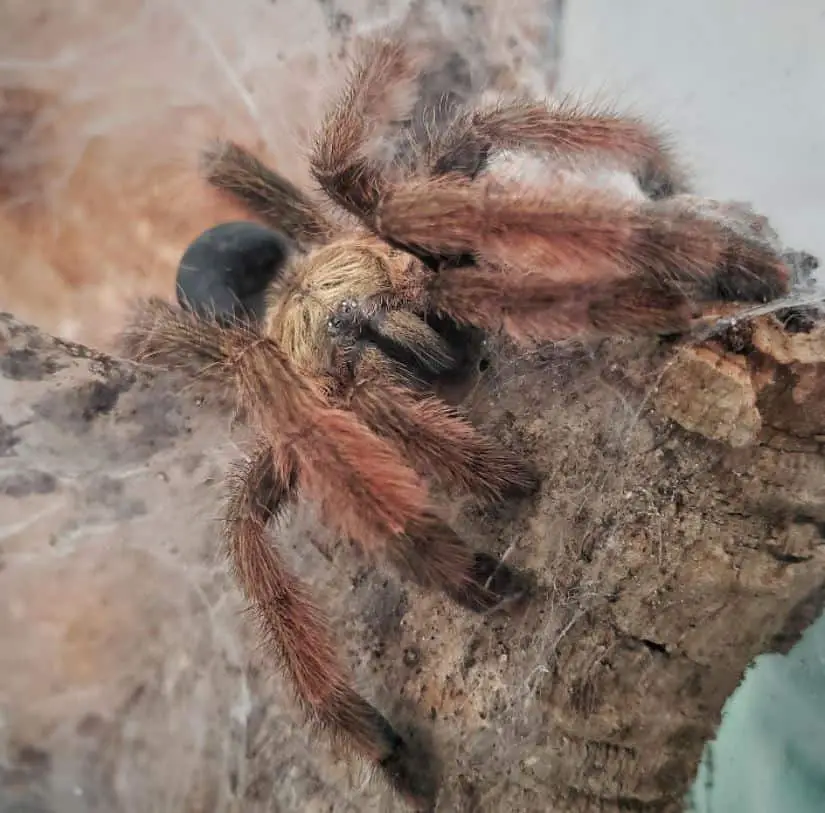The Panama Blonde Tarantula (Psalmopoeus pulcher) is a New World Arboreal species native to Panama. They’re known for their stunning blonde hair which gives them a fluffy appearance.
If this gorgeous species has caught your eye and you’re considering making it the latest addition to your collection, you’ve come to the right place. Today, we’ll go over everything you need to know about the Panama Blonde!

Panama Blonde Tarantula Care Sheet
| Species Name | Psalmopoeus pulcher |
| Family Name | Theraphosidae |
| Common Names | Panama Blonde Tarantula |
| Category | New World |
| Type | Arboreal |
| Native Location | Panama |
| Leg Span | 5″ to 5.5″ |
| Growth Speed | Fast |
| Urticating Hairs | Yes |
| Social | Solitary |
| Diet | Crickets, roaches, mealworms |
| Temperature | 75 to 85 degrees Fahrenheit |
| Humidity | 65 to 75% |
| Lifespan | Female: 12 years / Male: 3 to 4 years |
| Experience required | Beginner/intermediate |
| Minimum tank size | At least 4x leg span in vertical space |
Panama Blonde Tarantula Overview
The Panama Blonde Tarantula is an arboreal species that lives in the forests of Panama. It was first described by Petrunkevitch, in 1925.
As an arboreal tarantula, they spend most of their time in the trees where they ambush small insects to feed on.
They’re highly desired among hobbyists due to their intriguing blonde hair and cream-colored carapace.
Appearance

The Panama Blonde Tarantula is a very light-colored spider. Their carapace, abdomen, and legs are all cream in color. They do have some interesting black patterns and spots throughout their body. Especially their lower abdomen often has a thick black coloration.
They’re most well known for their interesting-looking setae, which are a light pink/orangish color, which makes the spider look blonde, which is where it gets its name from.
Males and females of this species look quite similar and are often difficult to tell apart. The primary difference between them is that females are typically larger than males.
They’re not the largest species out there, with females topping out at a size of about 5.5 inches.
An interesting distinction between this species is that the babies are typically very dark with lighter spots on their legs. They don’t get their distinctive light appearance until they grow older.
Price
The Panama Blonde is not a particularly expensive tarantula. You can find slings for sale for as little as $40.
Adults are slightly more expensive, but still do not break the bank. Males can be found for around $60, while females typically cost around $125.
Temperament & Behavior

Many species in the Psalmopoeus genus are quite defensive and erratic, but the Psalmopoeus pulcher is often an exception. They’re typically a calm species that is not quick to strike a threat posture.
When they feel like they’re being threatened, they prefer to run rather than fight if possible.
Of course, they’re still perfectly capable of defending themselves and should be handled with caution. They have urticating hairs which have to be avoided because they can be quite damaging if they end up in your eyes, nose, or mouth.
Like all tarantulas, they are capable of biting, but they’re not likely to do so unless they have no other choice.
Luckily, this species does not have very potent venom.
They’re also not very shy tarantulas and do not mind sitting out in the open, which makes them very suitable as display spiders! This, combined with their relatively docile temperament makes them suitable for people who are at around the beginner/intermedia level of the hobby.
Like most tarantula species, they are nocturnal, which means that they’ll be most active at night.
Handling
Tarantulas generally do not really enjoy being handled, but the Panama Blonde might tolerate it due to their docile nature. You should always be careful because they are in essence wild animals.
If you choose to handle the Panama Blonde, make sure that you avoid getting their urticating hairs in your eyes, nose, or mouth. Always wash your hands after interacting with them!
Also, you should be careful not to drop them.
Caring for a Panama Blonde Tarantula
Tank setup
Slings can be kept in a vial with a twig in it so that they can climb. As they grow larger though, they need to be moved to a larger enclosure. When they’re around 3 to 4 inches in size, they’re ready to be moved to their permanent enclosure.
Since the Panama Blonde is an arboreal species vertical space is more important in their terrarium than horizontal space.
Make sure that their enclosure is at least 4 times as tall as their leg span. So, if you have a 5-inch spider, give them at least 20 inches of vertical space.
For a hide, they need a hollow vertical branch or cork bark to climb into and feel at home.
This spider is quite a heavy webber and giving them plenty of twigs, rocks, and artificial plants will allow them to do their webbing more effectively.
In addition, giving them plenty of enrichment in their enclosure will make it more likely for them to leave their hide and wander around.
Substrate
The substrate is not quite as important for this species because they’re not terrestrial. They will spend the vast majority of their time in their tree.
Because of this, they will also not burrow which means that a two-inch layer of substrate is plenty. I recommend using a mixture of peat moss, vermiculite, and coconut fiber for the substrate.
Temperature & Humidity
When keeping tarantulas it’s always a good idea to try to mimic their natural climate as closely as possible. The Panama Blonde is from a warm and humid climate, which means that they’ll do well in similar circumstances in captivity.
Temperatures between 75 and 85 degrees Fahrenheit are ideal for them, while the humidity should ideally be between 65 and 75%. Ventilation is also important.
Social
There are some communal tarantulas, but the Panama Blonde is not one of those. They should not be housed with other members of their species because this will often result in cannibalism.
They should only really meet other spiders if they’re going to mate (and even that can end in cannibalism).
Molting
Since the Panama Blonde is a relatively fast-growing species, they will molt frequently. Molting is the process of the tarantula shedding its old exoskeleton so that it can keep growing.
Before your spider is about to molt, they will typically stop eating to make it easier for them to get out of their old skin.
After they’ve molted, they should not be fed for several days because they need time for their fangs to harden in order to be able to eat.
Diet & Feeding

Panama Blonde Slings should eat pre-killed baby crickets, cricket legs, or flightless fruit flies. There’s really no chance of overfeeding a sling, they will eat as much as they need in order to grow and then stop. Make sure to remove uneaten food so that it doesn’t start rotting.
As they grow bigger, their prey should grow with them. When they’re juveniles, they can start eating live crickets. When they’re adults, they can eat two Dubia roaches or 4 large crickets every week.
Some people also choose to feed their spiders small lizards or rodents, but this is not necessary.
They also need to drink. Adults can drink from a water bowl, while slings for slings you can drip small amounts of water down the side of their enclosure so that they can drink the drops.
Lifespan & Health
The Panama Blonde tarantula has a lifespan of 12 years for females and 3 to 4 years for males. In captivity, they can often live out their full lifespan without any problems.
The main things to look out for to keep them healthy are mold, parasites, and spider mites. Luckily, these are quite easy to prevent.
To prevent mold and mites, make sure that their enclosure has enough ventilation, remove uneaten food in time, and keep their enclosure clean.
Parasites can be prevented by not feeding your P. Pulcher wild-caught insects.
Final words: Is the Panama Blonde Tarantula right for you?
The Panama Blonde is a beautiful arboreal tarantula that’s famed for its blonde hairs. Their temperament, which is relatively docile for their genus, and weak venom make them suitable for hobbyists in the beginner/intermediate range.
In addition, the fact that they’re not shy, and tend to spend quite a bit of time out in the open makes them an excellent display spider. Even people who have years of experience might want to consider adding this species to their collection because she’s simply a beauty to look at!
- How Long Do American Eskimo Dogs Live? Important Factors and Care Tips - September 29, 2023
- Do American Bulldogs Need Grooming? Essential Tips and Care Guidelines - September 29, 2023
- Do Bengal Cats Enjoy Playing? Essential Tips for Keeping Them Active - September 29, 2023